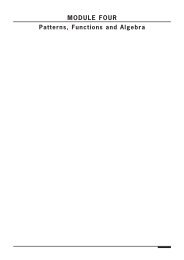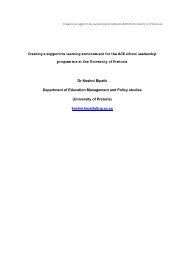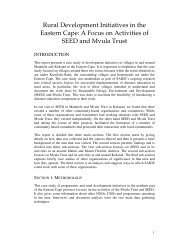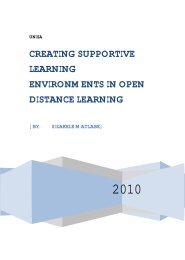Fundamentals in ECD - South African Institute for Distance Education
Fundamentals in ECD - South African Institute for Distance Education
Fundamentals in ECD - South African Institute for Distance Education
Create successful ePaper yourself
Turn your PDF publications into a flip-book with our unique Google optimized e-Paper software.
<strong>Fundamentals</strong> <strong>in</strong> <strong>ECD</strong> : Mathematical LiteracyLearner’s Manual<strong>Fundamentals</strong> Mathemactical LiteracyUnit Standards1. Unit Standard 7451Collect, analyze, use and communicate numerical dataSpecific Outcomes and Assessment Criteria:SO1:Identify situations <strong>for</strong> <strong>in</strong>vestigation and data collection and collect numericaldata.1. Situations <strong>for</strong> data collection are identified <strong>in</strong> terms of the purpose <strong>for</strong> datacollection.2. Appropriate methods are selected to collect data.3. A variety of appropriate data collection methods are used to collect data fromprimary and secondary sources. (Surveys, books, <strong>in</strong>terviews, observations,tally sheets and questionnaires.)4. The potential misuse of data achieved through the data collection method isdescribed.5. Reasons <strong>for</strong> and limitations of us<strong>in</strong>g sampl<strong>in</strong>g are described.SO2:Classify and analyze numerical data. (Grouped and ungrouped data.)1. Data is organized <strong>for</strong> mean<strong>in</strong>gful analysis. (Classification, order<strong>in</strong>g, list<strong>in</strong>g.)2. Analytical tools are used correctly and appropriately to analyze the data.(Median, mean, modes, frequency, range.3. The differences between and uses of mean, median and mode are described.SO3:Summarize and display organized numerical data. (Graphs: pie, frequencypolygon, histogram, simple bar graph, stem and leaf. Tables, basic tree diagrams.)1. The <strong>for</strong>m of display is appropriate to the data and context, and is justified <strong>in</strong>terms of its appropriateness.2. The scale is selected and used <strong>for</strong> a reasonable presentation of the data, and thescale is justified <strong>in</strong> terms of its reasonableness.3. Different <strong>for</strong>ms of display are identified and evaluated <strong>in</strong> terms of theirpurposes.SO4:Extract, <strong>in</strong>terpret and critically evaluate <strong>in</strong><strong>for</strong>mation from various <strong>for</strong>ms ofdisplay. (Graphs: pie, frequency polygon, histogram, simple bar graph, stem andleaf. Tables, basic tree diagrams.)1. The <strong>in</strong><strong>for</strong>mation extracted from the display is consistent with the display.2. The <strong>in</strong><strong>for</strong>mation is <strong>in</strong>terpreted to <strong>for</strong>m <strong>in</strong><strong>for</strong>med op<strong>in</strong>ions.3. Displays that distort <strong>in</strong><strong>for</strong>mation are identified and the manner <strong>in</strong> which theydistort <strong>in</strong><strong>for</strong>mation is described.4. The effect of distortions <strong>in</strong> displays is described <strong>in</strong> terms of the impact onmean<strong>in</strong>g <strong>in</strong> social, socio-historical, political and economic contexts.xiv
















